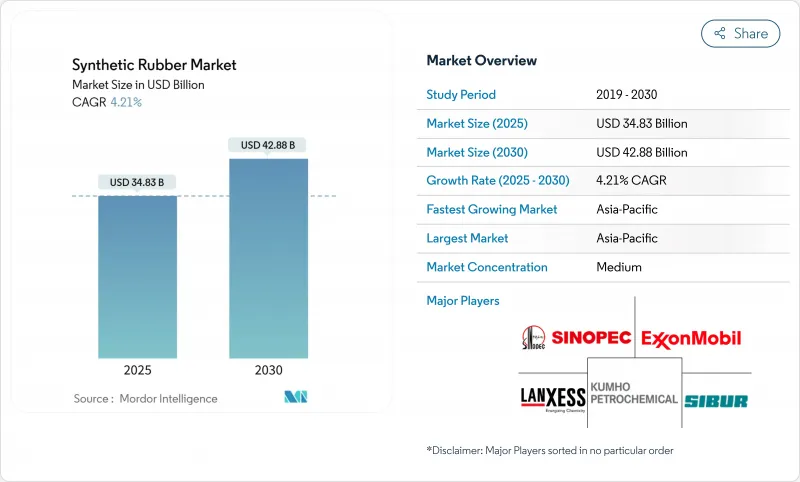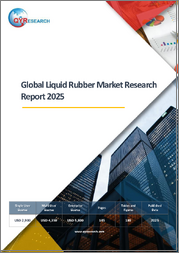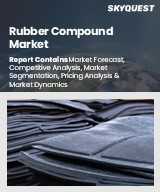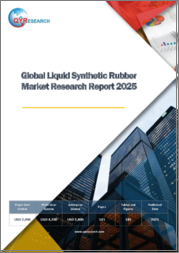
|
시장보고서
상품코드
1850131
합성 고무 시장 : 점유율 분석, 산업 동향, 통계, 성장 예측(2025-2030년)Synthetic Rubber - Market Share Analysis, Industry Trends & Statistics, Growth Forecasts (2025 - 2030) |
||||||
합성 고무 시장 규모는 2025년에 348억 3,000만 달러, 예측기간 중(2025-2030년) CAGR은 4.21%를 나타내고, 2030년에는 428억 8,000만 달러에 달할 것으로 예측됩니다.

원료 가격이 변동하고 환경 기준이 엄격해지더라도, 타이어 제조업체, 공업 제조업체, 헬스 케어·서플라이어로부터의 저단한 수요가 이 성장을 지지하고 있습니다. 전기자동차(EV)의 보급이 진행되고, 제품 사양이 재검토되고, 구름 저항의 저감과 마모 수명의 연장을 실현하는 용액 중합 등급이 공급자에게 요구되고 있습니다. 신재생에너지의 도입은 EPDM에 새로운 고부가가치 채널을 창출하고 의료와 소비재 분야는 고객층을 넓히고 있습니다. 동시에, 바이오 단량체는 OEM이 넷 제로를 추구함에 따라 급속히 확대되고 있으며, 이러한 전환은 기존의 석유 기반 제품의 마진 범위를 좁히고 있습니다.
세계 합성 고무시장 동향과 통찰
전기자동차 제조업체에 의한 고성능 타이어 수요 급증
EV는 배터리 팩이 무겁고, 순간적으로 토크가 발생하기 때문에 타이어의 마모가 20-30% 가속합니다. 따라서 타이어 제조업체는 구름 저항을 줄이고 수명을 연장하는 솔루션 중합 SBR을 지정했습니다. 2024년 후반에 도입된 브리지스톤의 PeakLife 폴리머는 실리카와의 상호작용을 강화하고 EV의 내구성 목표를 충족시킵니다. 중국과 유럽의 EV 어셈블러로부터의 지속적인 조달은 이 기술 요건을 합성 고무 시장의 구조적 견인력으로 바꿉니다.
재생에너지 설비에서 산업용 고무 제품의 성장
풍력 터빈용 케이블, 태양전지판용 개스킷, 수력 발전용 씰은 내후성과 전기 절연성에서 EPDM에 의존합니다. 해양풍력발전소에서의 자외선 노출은 480시간 후에 EPDM의 기계적 특성을 27.67% 저하시킨다는 연구결과가 있으며, 현장의 내구성을 유지하기 위한 컴파운드의 기술 혁신에 박차를 가하고 있습니다. 북해와 중국 동부 연안의 해상 풍력 발전의 용량 확대는 수요 증가를 촉진합니다.
증기 크래커의 작동 중지로 인한 부타디엔 원료 가격 변동
프랑스, 네덜란드, 이탈리아에서 예정된 스팀 크래커의 작동 정지로 인해 유럽 원유 C4공급 능력이 저하되고 SBR 원료 비용의 약 50%를 차지하는 부타디엔 가격이 상승합니다. 금리가 줄어들면서 아시아 생산자들은 화물을 서쪽으로 우회시키지만 물류 제약과 천연가스 가격 상승으로 변동성이 높아지고 있습니다.
부문 분석
스티렌 부타디엔 고무(SBR)는 2024년 시장 점유율에서 40%를 차지하며 지배적인 지위를 유지합니다. 이것은 주로 타이어 제조에 널리 사용되며 견인력과 내마모성을 높이기 위해서입니다. SBR은 그립력과 내마모성의 균형이 잡혀 있기 때문에 승용차의 트레드에는 빼놓을 수 없습니다. 한편 EPDM은 2030년까지 연평균 복합 성장률(CAGR) 5.77%로 성장하여 재생가능에너지 사업자가 케이블의 피복 및 밀봉에 지정하고 있기 때문에 모든 유형 중에서 가장 빠릅니다. EPDM의 30-50년의 수명을 가진 지붕재는 보다 엄격한 기후 패턴에 대응하는 건설 계약자에게도 매력적입니다.
수요의 다양화가 진행됩니다. 폴리부타디엔 고무는 SBR과 블렌딩하여 겨울용 타이어의 저온 유연성을 향상시키고, 이소부틸렌 이소프렌 고무는 가스 투과성을 최소화해야 하는 의약품 스토퍼를 지원합니다. 폴리이소프렌은 천연 라텍스 알레르겐의 제거를 목표로 하는 카테터 제조업체나 장갑 제조업체를 매료하고 있습니다. NBR 및 CR과 같은 특수 등급은 오일 서비스 호스 및 난연성 케이블에 채택됩니다. 이와 같은 등급의 확대로 컴파운드 제조업체는 최종 용도에 맞게 성능을 조정하고 가격 결정력을 유지할 수 있습니다.
유화 중합은 반응기가 확립되어 비용 효율적이고 고도로 자동화되어 있기 때문에 2024년 합성 고무 시장 점유율의 60%를 차지합니다. 그러나 용액 중합 등급의 합성 고무 시장 규모는 CAGR 5.51%로 증가할 것입니다. 용액 반응 장치에서 제조되는 선형 거대 분자와 좁은 분자량 분포는 탄성률을 18.7MPa로 향상시킵니다.
고급 연속 중합은 실시간 분석을 사용하여 단량체 공급량을 조정하고 VOC 배출량을 줄이고 정확한 아키텍처 제어를 가능하게 합니다. 발자국은 가장 작지만 재현성이 비용을 능가하는 틈새 의료 및 항공우주 수요를 이미 지원합니다. 생산자는 사이트 확장을 선택하기 전에 공정 유연성, 에너지 강도 및 탄소 발자국 간의 설비 투자의 절충을 고려합니다.
지역 분석
아시아태평양은 2024년에 합성 고무 시장의 57%를 차지했고, 2030년까지의 CAGR은 4.38%를 나타낼 전망입니다. 중국은 EV의 급속한 보급으로 타이어와 자동차 부품의 수출이 확대되고 있으며, 이 주도권을 잡고 있습니다. 인도, 베트남, 태국은 그린필드의 복합 공장을 통해 지역적인 기세를 늘리고 있습니다. 사탕수수로부터 바이오 BDO를 제조하는 효순의 베트남 프로젝트는 2026년까지 최초의 종합 바이오베이스 엘라스탄 센터를 설립했으며, 당초에는 연간 5만 톤을 생산할 예정입니다.
북미에서는 첨단 연구개발과 급증하는 바이오함량규제가 결합되어 있습니다. 국립재생에너지연구소는 재활용가능한 타이어를 위한 가역적 가교프로토타입을 개발하고, 노스캐롤라이나 주립대학은 국내 고무 공급의 탄력성을 강화하기 위한 전미과학재단센터를 공동 주재하고 있습니다. UPS와 아마존과 같은 선도적 인 함대 고객은 지속 가능한 타이어를 시험적으로 도입했으며 바이오 원료 생산자에게 풀 스루 효과를 제공합니다.
유럽은 스팀 크래커 폐쇄로 부타디엔 공급이 급박했음에도 불구하고 여전히 프리미엄 허브의 지위를 유지하고 있습니다. 독일, 프랑스, 이탈리아는 엄격한 REACH 규정과 마이크로 플라스틱 규정을 준수하는 고성능 특수 등급에 주력하고 있습니다. 유럽위원회의 바이오 제조 프로그램은 수입 의존도와 탄소 강도를 줄이기 위해 천연 및 합성 고무 모두의 대체 경로에 자금을 제공합니다.
기타 혜택 :
- 엑셀 형식 시장 예측(ME) 시트
- 3개월의 애널리스트 서포트
목차
제1장 서론
- 조사의 전제조건과 시장의 정의
- 조사 범위
제2장 조사 방법
제3장 주요 요약
제4장 시장 상황
- 시장 개요
- 시장 성장 촉진요인
- EV 제조업체에 의한 고성능 타이어 수요 급증
- 신재생에너지시설에서 공업용 고무품의 성장
- 의료 및 헬스케어 용도의 진보
- 탄소중립 이행에 따른 북미 지역의 바이오 기반 모노머 전환 추세
- 소비재 부문의 성장
- 시장 성장 억제요인
- 증기 크래커의 턴어라운드에 의한 부타디엔 원료 가격의 변동
- 씰과 개스킷의 고성능 폴리우레탄의 대체
- 환경과 규제에 대한 우려
- 밸류체인 분석
- Porter's Five Forces 분석
- 공급기업의 협상력
- 구매자의 협상력
- 신규 참가업체의 위협
- 대체품의 위협
- 경쟁도
제5장 시장 규모와 성장 예측
- 유형별
- 스티렌 부타디엔 고무(SBR)
- 폴리부타디엔 고무(BR)
- 에틸렌 프로파일렌 디엔 단량체(EPDM)
- 이소부틸렌 이소프렌 고무(IIR)
- 폴리이소프렌 고무(IR)
- 기타(NBR, CR, ACM, HNBR 등)
- 제조 공정별
- 유화 중합(E-SBR)
- 용액 중합(S-SBR)
- 고급 연속 중합
- 원재료별
- 부타디엔
- 이소프렌
- 스티렌
- 에틸렌과 프로파일렌
- 기타 특수 단량체(ACN, 클로로프렌)
- 용도별
- 타이어와 타이어 부품
- 타이어 이외의 자동차 용도
- 공업제품
- 신발
- 기타 용도
- 지역별
- 아시아태평양
- 중국
- 인도
- 일본
- 한국
- 말레이시아
- 태국
- 베트남
- 인도네시아
- 기타 아시아태평양
- 북미
- 미국
- 캐나다
- 멕시코
- 유럽
- 독일
- 영국
- 프랑스
- 이탈리아
- 스페인
- 러시아
- 북유럽 국가
- 튀르키예
- 기타 유럽
- 남미
- 브라질
- 아르헨티나
- 콜롬비아
- 기타 남미
- 중동 및 아프리카
- 사우디아라비아
- 아랍에미리트(UAE)
- 카타르
- 남아프리카
- 이집트
- 나이지리아
- 기타 중동 및 아프리카
- 아시아태평양
제6장 경쟁 구도
- 시장 집중도
- 전략적 동향
- 시장 점유율 분석
- 기업 프로파일
- Apcotex Industries
- Arlanxeo
- Asahi Kasei Corporation
- China Petrochemical Corporation
- Dow
- ENEOS Corporation
- Exxon Mobil Corporation
- Jiangsu Sailboat Petrochemical Co. Ltd.
- Kumho Petrochemical
- LANXESS
- LG Chem
- Mitsubishi Chemical Group Corporation
- Reliance Industries Limited
- SABIC
- Saudi Arabian Oil Co.
- SIBUR Holding PJSC
- Synthos
- The Goodyear Tire & Rubber Company
- Trinseo
- TSRC
- Versalis SpA
- Zeon Corporation
제7장 시장 기회와 장래의 전망
SHW 25.11.07The Synthetic Rubber Market size is estimated at USD 34.83 billion in 2025, and is expected to reach USD 42.88 billion by 2030, at a CAGR of 4.21% during the forecast period (2025-2030).

Resilient demand from tire producers, industrial manufacturers, and healthcare suppliers underpins this growth even as feedstock prices fluctuate and environmental standards tighten. Rising electric-vehicle (EV) adoption is reshaping product specifications, pushing suppliers toward solution-polymerized grades that deliver lower rolling resistance and extended wear life. Renewable-energy installations are creating new high-value channels for EPDM, while medical and consumer goods segments are broadening the customer base. At the same time, bio-based monomers are scaling rapidly as OEMs chase net-zero commitments, and this transition is compressing the margin window for legacy petroleum-based output.
Global Synthetic Rubber Market Trends and Insights
Surging Demand for High-Performance Tires from EV OEMs
EVs accelerate tire wear by 20-30% because of heavier battery packs and instant torque, prompting tire makers to specify solution-polymerized SBR that lowers rolling resistance and extends lifespan. Bridgestone's PeakLife polymer, introduced in late 2024, enhances silica interaction and meets EV durability targets. Continuous procurement from Chinese and European EV assemblers converts this technical requirement into a structural pull on the synthetic rubber market.
Growth of Industrial Rubber Goods in Renewable-Energy Installations
Wind-turbine cables, solar-panel gaskets, and hydroelectric seals rely on EPDM for weatherability and electrical insulation. Studies show UV exposure in marine wind farms can reduce EPDM mechanical properties by 27.67% after 480 hours, spurring compound innovation to preserve field durability. Capacity additions in offshore wind clusters around the North Sea and China's eastern seaboard drive incremental demand.
Volatility in Butadiene Feedstock Prices from Steam-Cracker Turnarounds
Steam-cracker shutdowns scheduled in France, the Netherlands, and Italy trim European crude C4 availability and lift butadiene prices, which represent roughly 50% of SBR raw-material cost. Margin squeeze prompts Asian producers to divert cargoes westward, yet logistics constraints and natural-gas price spikes keep volatility high.
Other drivers and restraints analyzed in the detailed report include:
- Advancements in Medical and Healthcare Applications
- Shift Toward Bio-Based Monomers in North America Driven by Net-Zero Commitments
- Substitution by High-Performance Polyurethanes in Seals & Gaskets
For complete list of drivers and restraints, kindly check the Table Of Contents.
Segment Analysis
Styrene-Butadiene Rubber (SBR) maintains its dominant position with 40% market share in 2024, primarily due to its extensive use in tire manufacturing, where it enhances traction and wear resistance. SBR remains indispensable for passenger-car treads because it balances grip and abrasion. EPDM, however, advances at 5.77% CAGR through 2030, the fastest among all types, as renewable-energy operators specify it for cable sheathing and sealing. EPDM's 30-50-year service life in roofing also appeals to construction contractors navigating harsher climate patterns.
Demand diversification intensifies. Polybutadiene Rubber blends with SBR to improve low-temperature flexibility in winter tires, while Isobutylene-Isoprene Rubber supports pharmaceutical stoppers where gas permeability must stay minimal. Polyisoprene attracts catheter and glove makers aiming to eliminate natural-latex allergens. Specialty grades such as NBR and CR find traction in oil-service hoses and flame-retardant cables. This expanding palette lets compounders tailor performance to discrete end-use conditions and retain pricing power.
Emulsion polymerization output accounted for 60% of synthetic rubber market share in 2024 as its reactors are established, cost efficient and highly automated. Yet the synthetic rubber market size attached to solution-polymerized grades will rise at 5.51% CAGR. Linear macro-molecules and narrow molecular-weight distributions produced in solution reactors improve elastic modulus to 18.7 MPa, a critical attribute for high-speed EV tires.
Advanced continuous polymerization uses real-time analytics to adjust monomer feeds, cutting VOC emissions, and enabling precise architecture control. Although its footprint is the smallest, it already underpins niche medical and aerospace demand where reproducibility trumps cost. Producers weigh capex trade-offs between process flexibility, energy intensity and carbon footprint before selecting site expansions.
The Synthetic Rubber Market Report Segments the Industry Into by Type (Styrene Butadiene Rubber (SBR), Polybutadiene Rubber (BR), and More), by Manufacturing Process (Emulsion Polymerization (E-SBR), Solution Polymerization (S-SBR), and More), by Raw Material (Butadiene, Isoprene, and More), by Application (Tire and Tire Components, Industrial Goods, and More), and Geography (Asia-Pacific, North America, Europe, and More).
Geography Analysis
Asia-Pacific commanded 57% of the synthetic rubber market in 2024 and is increasing volume at a 4.38% CAGR to 2030. China anchors this leadership with expansive tire and auto-parts exports, augmented by quickening EV penetration. India, Vietnam and Thailand add regional momentum through greenfield compounding plants. Hyosung's Vietnam project to derive BIO BDO from sugarcane will create the first integrated bio-based elastane center by 2026, initially rated at 50,000 tons per year.
North America combines advanced R&D with surging bio-content mandates. The National Renewable Energy Laboratory is prototyping reversible crosslinks for recyclable tires, and NC State University co-leads a National Science Foundation center to bolster domestic rubber supply resilience. Large fleet clients such as UPS and Amazon are piloting sustainable tires, creating a pull-through effect for bio-based feedstock producers.
Europe remains a premium hub despite steam-cracker closures tightening butadiene supply. Germany, France and Italy focus on high-performance specialty grades that meet stringent REACH and microplastic regulations. The European Commission's bio-manufacturing program finances alternative routes for both natural and synthetic rubber to cut import reliance and carbon intensity.
- Apcotex Industries
- Arlanxeo
- Asahi Kasei Corporation
- China Petrochemical Corporation
- Dow
- ENEOS Corporation
- Exxon Mobil Corporation
- Jiangsu Sailboat Petrochemical Co. Ltd.
- Kumho Petrochemical
- LANXESS
- LG Chem
- Mitsubishi Chemical Group Corporation
- Reliance Industries Limited
- SABIC
- Saudi Arabian Oil Co.
- SIBUR Holding PJSC
- Synthos
- The Goodyear Tire & Rubber Company
- Trinseo
- TSRC
- Versalis S.p.A.
- Zeon Corporation
Additional Benefits:
- The market estimate (ME) sheet in Excel format
- 3 months of analyst support
TABLE OF CONTENTS
1 Introduction
- 1.1 Study Assumptions and Market Definition
- 1.2 Scope of the Study
2 Research Methodology
3 Executive Summary
4 Market Landscape
- 4.1 Market Overview
- 4.2 Market Drivers
- 4.2.1 Surging Demand for High-Performance Tires from EV OEMs
- 4.2.2 Growth of Industrial Rubber Goods in Renewable-Energy Installations
- 4.2.3 Advancements in Medical and Healthcare Applications
- 4.2.4 Shift Toward Bio-Based Monomers in North America Driven by Net-Zero Commitments
- 4.2.5 Growth in Consumer Goods Sector
- 4.3 Market Restraints
- 4.3.1 Volatility in Butadiene Feedstock Prices from Steam-Cracker Turnarounds
- 4.3.2 Substitution by High-Performance Polyurethanes in Seals and Gaskets
- 4.3.3 Environmental and Regulatory Concerns
- 4.4 Value Chain Analysis
- 4.5 Porter's Five Forces Analysis
- 4.5.1 Bargaining Power of Suppliers
- 4.5.2 Bargaining Power of Buyers
- 4.5.3 Threat of New Entrants
- 4.5.4 Threat of Substitutes
- 4.5.5 Degree of Competition
5 Market Size and Growth Forecasts (Value)
- 5.1 By Type
- 5.1.1 Styrene-Butadiene Rubber (SBR)
- 5.1.2 Polybutadiene Rubber (BR)
- 5.1.3 Ethylene-Propylene-Diene Monomer (EPDM)
- 5.1.4 Isobutylene-Isoprene Rubber (IIR)
- 5.1.5 Polyisoprene Rubber (IR)
- 5.1.6 Others (NBR, CR, ACM, HNBR, etc.)
- 5.2 By Manufacturing Process
- 5.2.1 Emulsion Polymerization (E-SBR)
- 5.2.2 Solution Polymerization (S-SBR)
- 5.2.3 Advanced Continuous Polymerization
- 5.3 By Raw Material
- 5.3.1 Butadiene
- 5.3.2 Isoprene
- 5.3.3 Styrene
- 5.3.4 Ethylene and Propylene
- 5.3.5 Other Specialty Monomers (ACN, Chloroprene)
- 5.4 By Application
- 5.4.1 Tire and Tire Components
- 5.4.2 Non-Tire Automobile Applications
- 5.4.3 Industrial Goods
- 5.4.4 Footwear
- 5.4.5 Other Applications
- 5.5 By Geography
- 5.5.1 Asia-Pacific
- 5.5.1.1 China
- 5.5.1.2 India
- 5.5.1.3 Japan
- 5.5.1.4 South Korea
- 5.5.1.5 Malaysia
- 5.5.1.6 Thailand
- 5.5.1.7 Vietnam
- 5.5.1.8 Indonesia
- 5.5.1.9 Rest of Asia-Pacific
- 5.5.2 North America
- 5.5.2.1 United States
- 5.5.2.2 Canada
- 5.5.2.3 Mexico
- 5.5.3 Europe
- 5.5.3.1 Germany
- 5.5.3.2 United Kingdom
- 5.5.3.3 France
- 5.5.3.4 Italy
- 5.5.3.5 Spain
- 5.5.3.6 Russia
- 5.5.3.7 Nordics
- 5.5.3.8 Turkey
- 5.5.3.9 Rest of Europe
- 5.5.4 South America
- 5.5.4.1 Brazil
- 5.5.4.2 Argentina
- 5.5.4.3 Colombia
- 5.5.4.4 Rest of South America
- 5.5.5 Middle East and Africa
- 5.5.5.1 Saudi Arabia
- 5.5.5.2 United Arab Emirates
- 5.5.5.3 Qatar
- 5.5.5.4 South Africa
- 5.5.5.5 Egypt
- 5.5.5.6 Nigeria
- 5.5.5.7 Rest of Middle East and Africa
- 5.5.1 Asia-Pacific
6 Competitive Landscape
- 6.1 Market Concentration
- 6.2 Strategic Moves
- 6.3 Market Share Analysis
- 6.4 Company Profiles (includes Global level Overview, Market level Overview, Core Segments, Financials as available, Strategic Information, Market Rank/Share for key companies, Products and Services, and Recent Developments)
- 6.4.1 Apcotex Industries
- 6.4.2 Arlanxeo
- 6.4.3 Asahi Kasei Corporation
- 6.4.4 China Petrochemical Corporation
- 6.4.5 Dow
- 6.4.6 ENEOS Corporation
- 6.4.7 Exxon Mobil Corporation
- 6.4.8 Jiangsu Sailboat Petrochemical Co. Ltd.
- 6.4.9 Kumho Petrochemical
- 6.4.10 LANXESS
- 6.4.11 LG Chem
- 6.4.12 Mitsubishi Chemical Group Corporation
- 6.4.13 Reliance Industries Limited
- 6.4.14 SABIC
- 6.4.15 Saudi Arabian Oil Co.
- 6.4.16 SIBUR Holding PJSC
- 6.4.17 Synthos
- 6.4.18 The Goodyear Tire & Rubber Company
- 6.4.19 Trinseo
- 6.4.20 TSRC
- 6.4.21 Versalis S.p.A.
- 6.4.22 Zeon Corporation
7 Market Opportunities and Future Outlook
- 7.1 White-Space and Unmet-Need Assessment
- 7.2 Development of Bio-Based Synthetic Rubbers



















